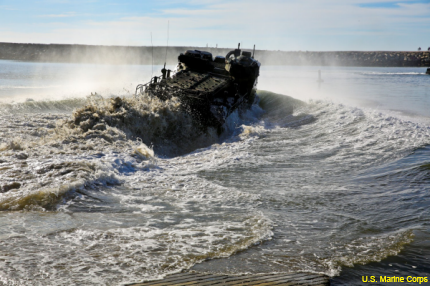Corrosion-fighting rubber could extend life of Marines’ amphibious vehicles
The Navy Research Lab says polyureas rubber also protects against ballistics.

The Marines’ ship-to-shore vehicles can corrode after being in the water.
The Navy Research Laboratory is working with a rare type of rubber for the Marine Corps’ amphibious assault vehicles that not only protects against corrosion, but potentially protects against ballistics, too. NRL researchers said the rubber solution will prolong the life of the AAV, which has been in use since 1972, until around 2035.
The Marines had been bolting armor to their AAVs, which serve to transport soldiers from ship to shore in highly contested environments, for the last 25 years. However, the process of armoring the vehicles was not very efficient. It included a layer of laminate high hard steel, which is good for ballistics protection, a rubber layer and another soft steel layer. Because AAVs operate both on land and in water—giving the Marines a capability no other service has—the armor gets corroded with exposure to water and the corrosion engenders cracks.
"You've got steel, rubber, steel—and these things are thermally expanding and contracting differently," said Dr. Mike Roland, who along with Dr. Ray Gamache led the research at NRL. "In addition to which, AAVs aren't driven like expensive Volvos; they're banging into stuff—and now you've got a way for water ingress."
Specific types of rubber called polyureas showcased by NRL are better at protecting the armor because they stretch with it rather than cracking. Polyurea coatings slow bullets and blast fragments as “[t]hey take kinetic energy from the bullet...[s]o the bullet, to keep penetrating, it's meeting an increasingly resistant medium,” Roland said. “And if it slows down enough—it always makes it to the steel plate, but it doesn't have enough velocity to get through it."
The Marines’ AAV had been slated to be replaced by a newer ship-to-shore transport vehicle called the Expeditionary Fighting Vehicle, but after cost growth and poor test performances, that program was cancelled in 2011. Following the demise of the EFV program, the Marines and Congress decided to focus on the more modest Amphibious Combat Vehicle program to replace the 40-year-old AAV, though the AAV will continue to be used until a suitable replacement is fully developed.
Polyureas can be found in pickup truck bed-liners, despite not being as common as other conventional rubbers. The combination of chemical bonds found in polyureas greatly contributes to its functionality for NRL’s purpose. Polyureas have more hydrogen bonding, which is a weaker chemical bond than covalent bonds, which makes them more flexible and pliable. Moreover, hydrogen bonds enable the rubber to reform.
"In conventional materials, you can have something that's really stiff but doesn't stretch much; or you can have something really soft, like silly putty, and it stretches a lot," Roland said. "Polyureas, they can stretch to 10 times their original length, but the force it takes to do that is enormous—so you get toughness, the best of both worlds."